US Pharm. 2015;40(12):HS17-HS21.
ABSTRACT: Drug-induced bleeding presents in many ways, including excessive bruising, nosebleeds, heavy menses, gastrointestinal bleeding, and rectal bleeding. Drug-induced bleeding is potentiated by numerous drugs, natural medicines, and drug-drug interactions. Pharmacists should be aware of patient-specific risk factors and should actively monitor for medications that contribute to bleeding. By minimizing the risk of drug-induced bleeding in patients, pharmacists have the opportunity to reduce long-term adverse effects. In addition, pharmacists can educate patients on ways to reduce the risk of drug-induced bleeding and help them recognize the symptoms of drug-induced bleeding.
Drug-induced bleeding is commonly thought of as gastrointestinal (GI) bleeding resulting from the use of nonsteroidal anti-inflammatory drugs (NSAIDs). Nosebleeds and abnormal bruising, in addition to GI bleeding, may be linked to the use of oral anticoagulants. Hemorrhoidal bleeding may be associated with drugs that cause constipation. In addition, other predictors that may contribute to or cause an increase in bleeding include advancing age, the use of multiple drugs, drug-drug interactions, and coexisting diseases or conditions. This article will focus on drug-induced bleeding that is caused primarily by agents other than NSAIDs.
Drugs That Increase Bleeding Risk
Certain drug classes are known to increase the risk of bleeding (TABLE 1).1-3 Of interest are drugs used in the treatment of depression. Selective serotonin reuptake inhibitors and selective norepinephrine reuptake inhibitors are reported to inhibit the reuptake of serotonin into platelets, resulting in an increased risk of bleeding.4 These agents may have additive effects when taken concomitantly with other drugs known to cause bleeding. Fluoxetine and fluvoxamine pose additional risks since they inhibit warfarin metabolism by CYP450 enzymes.4 Bupropion, mirtazapine, and trazodone may be less likely to cause bleeding because they have weak affinity for the serotonin transporter.5
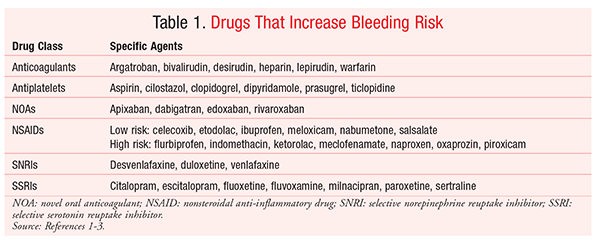
Anticoagulants and Antiplatelets
Anticoagulants are used for the prevention and treatment of deep venous thrombosis, pulmonary embolism, and thromboembolism and for the prevention of stroke in atrial fibrillation.6 Common anticoagulants and antiplatelets include aspirin, enoxaparin, clopidogrel, heparin, warfarin, and the novel oral anticoagulants (NOAs) apixaban, dabigatran, rivaroxaban, and edoxaban.
Warfarin inhibits vitamin K–dependent factors II, VII, IX, and X in the liver, and its effects can be reversed with the administration of vitamin K. NOAs are direct inhibitors of factor Xa (rivaroxaban, apixaban, edoxaban) and thrombin (factor IIa, dabigatran). Bleeding associated with their use is treated with the administration of RBCs and plasma, activated prothrombin complex concentrate, or recombinant factor VIIa, hemodialysis, or idarucizumab for dabigatran.6,7 The treatment of bleeding associated with NOAs is both controversial and expensive.
Special Consideration for NOAs
For dabigatran, rivaroxaban, and edoxaban, dosages should correspond to the patient’s age and renal function.8 In patients with a history of GI bleeding, apixaban or warfarin should be considered since dabigatran and rivaroxaban may confer a higher risk of bleeding.9,10 In patients with inflammatory bowel disease or diverticulosis, caution should be exercised with dabigatran and rivaroxaban since these agents are associated with both lower- and upper-GI bleeding.8 Caution with dabigatran and rivaroxaban also is necessary in patients who are underweight.8 A common complaint with dabigatran is dyspepsia. This symptom may be perplexing to patients who cannot differentiate between dyspepsia and abdominal pain associated with bleeding.11
Constipating Agents
Untreated constipation can lead to complications, including hemorrhoids, anal fissures with rectal bleeding, and rectal prolapse.12 Bright red blood on toilet paper or in the toilet bowl usually indicates bleeding low in the colon or rectum. See TABLE 2 for a list of drugs that cause constipation and thereby could potentiate bleeding.12,13
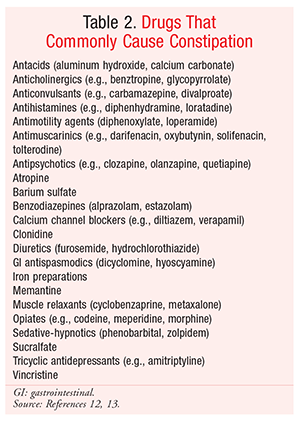
Natural Medicines
Certain natural medicines and supplements have been reported to cause bleeding either on their own or when used in combination with other drugs. TABLE 3 lists common natural medicines that affect platelet aggregation and could elicit bleeding.14
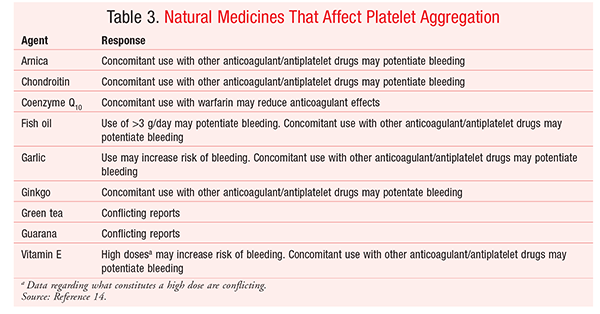
Drug-Drug Interactions
Medication reconciliation and patient education prevent moderate or significant drug-drug interactions. Selected drug-drug interactions are given in TABLE 4.11,15-22 Notable drug-drug interactions involve antibiotics and antifungals, which have been reported to increase bleeding when used in combination with drugs that are known to cause bleeding. It is recommended to check the international normalized ratio (INR) 5 days after initiation of an antimicrobial or antibiotic in patients taking warfarin.23 Another combination that is important to monitor for bleeding is that of proton pump inhibitors (PPIs) with clopidogrel, owing to their inhibition of CYP2C19. Pantoprazole seems to inhibit CYP2C19 less than other PPIs and is likely the safest option if concomitant PPI therapy is necessary.24
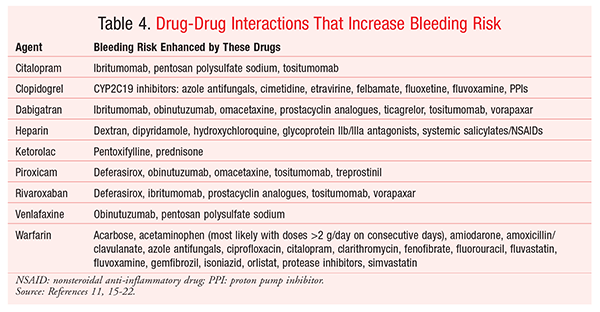
Risk Factors
Risk factors for increased bleeding include use of a drug or natural medicine that has the potential for bleeding (TABLES 1-3); concomitant use of drugs causing drug-drug interactions (TABLE 4); advancing age; prior history of GI bleeding; decreased renal function; uncontrolled hypertension; regular or excessive use of alcohol; and the presence of Helicobacter pylori.9 Additional risk factors associated with NSAID administration include concomitant use of oral bisphosphonates or corticosteroids; chronic debilitating disorders, such as cardiovascular disease and rheumatoid arthritis; and cigarette smoking.25 The accompanying CASE STUDY focuses on risk factors and signs and symptoms of bleeding.
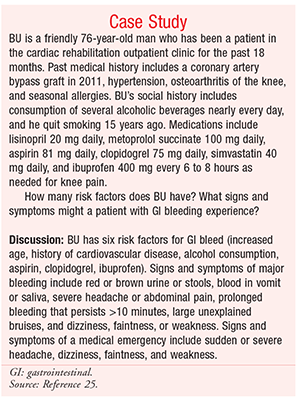
Patient Education
Prescribing information and FDA Medication Guides instruct patients to immediately contact their healthcare provider if symptoms of bleeding are present. Signs and symptoms of minor bleeding include gum bleeding, occasional nosebleeds, easy bruising, or bleeding that takes longer than normal to stop. Signs and symptoms of major bleeding include red or dark brown urine or stools; blood in vomit or saliva; severe headache or abdominal pain; prolonged bleeding that persists >10 minutes; large, unexplained bruises; dizziness, faintness, or weakness; extremely heavy menstrual flow; and vaginal bleeding.26
Education on reducing the risk of bleeding includes the recommendation to avoid all drugs that interact with anticoagulants and other drugs known to potentiate bleeding (TABLES 1 and 2). The use of NSAIDs is common since these agents can be purchased OTC for pain relief. If analgesia is needed, acetaminophen at a maximum dosage of 2 g per day may be used.27 Aspirin should be taken only if it is prescribed. The use of a PPI should be considered for patients at risk for GI bleeding. Patients should be counseled not to double up on doses in the event of missing a dose and not to skip doses in an effort to save money.
Patients should be encouraged to document their compliance with an electronic device or on a calendar.9 Any serious injury or fall should be reported if a patient is taking a medication known to potentiate bleeding (TABLE 1) so that signs and symptoms of bleeding can be monitored. A current medication card should be maintained at all times so that all healthcare providers are aware of all medications. In some cases, a sudden or severe episode of headache, dizziness, faintness, or weakness will occur before the medical emergency. Other emergency symptoms that are linked to bleeding or stroke include unusual pain or swelling and abnormalities in vision, speech, or gait. Dietary guidelines to maintain a consistent diet are important for patients taking warfarin. Sudden changes in diet to include high or extra intake of green, leafy vegetables or other foods high in vitamin K will cause the blood to clot, resulting in a lower INR and an increased risk of bleeding.1
Finally, patients who are taking drugs that could potentiate bleeding because of constipation should be advised to increase fruit and vegetable intake, increase fluid intake, make sure that at least one-half of all grains they consume are whole grains, and consume 25 g to 38 g of fiber daily.12 These patients should also be counseled on how to recognize constipation (decrease in frequency of bowel movements, dull headache, low back pain, abdominal distention, lower abdominal distress).12 OTC treatment with fiber laxatives or stool softeners is appropriate.12
Role of the Pharmacist
In addition to patient education on the signs of bleeding and how to minimize bleeding risk, pharmacists play an important role in helping reduce the risk of drug-induced bleeding by monitoring patient medication profiles for potential drug-drug interactions and by conducting patient interviews to identify other items that may increase risk, such as advanced age, alcohol consumption, use of natural medicines, past medical history, and family history.
Conclusion
Bleeding as a result of medication therapy is a severe complication that has a negative impact on patient safety. In many cases, bleeding is not easily identified as a drug-induced problem. Pharmacists can play a pivotal role in minimizing the development of drug-induced bleeding by being aware of the contributing risk factors and medications.
REFERENCES
1. Coumadin (warfarin) product information. Princeton, NJ: Bristol-Myers Squibb Co; October 2011.
2. Anglin R, Yuan Y, Moayyedi P, et al. Risk of upper gastrointestinal bleeding with selective serotonin reuptake inhibitors with or without concurrent nonsteroidal anti-inflammatory use: a systematic review and meta-analysis. Am J Gastroenterol. 2014;109:811-819.
3. Antman EM, Bennett JS, Daugherty A, et al. Use of nonsteroidal anti-inflammatory drugs: an update for clinicians: a scientific statement from the American Heart Association. Circulation. 2007;115:1634-1642.
4. Cochran KA, Cavallari LH, Shapiro NL, Bishop JR. Bleeding incidence with concomitant use of antidepressants and warfarin. Ther Drug Monit. 2011;33:433-438.
5. van Walraven C, Mamdani MM, Wells PS, Williams JI. Inhibition of serotonin reuptake by antidepressants and upper gastrointestinal bleeding in elderly patients: retrospective cohort study. BMJ. 2001;323:655-658.
6. Desai J, Kolb JM, Weitz JI, Aisenberg J. Gastrointestinal bleeding with the new oral anticoagulants—defining the issues and the management strategies. Thromb Haemost. 2013;110:205-212.
7. FDA. Idarucizumab. www.fda.gov/drugs/informationondrugs/approveddrugs/ucm467396.htm Accessed November 19, 2015.
8. Desai J, Granger CB, Weitz JI, Aisenberg J. Novel oral anticoagulants in gastroenterology practice. Gastrointest Endosc. 2013;78:227-239.
9. Harper P, Young L, Merriman E. Bleeding risk with dabigatran in the frail elderly. N Engl J Med. 2012;366:864-866.
10. Chang HY, Zhou M, Tang W, et al. Risk of gastrointestinal bleeding associated with oral anticoagulants: population based retrospective cohort study. BMJ. 2015;350:h1585.
11. Pradaxa (dabigatran) product information. Ridgefield, CT: Boehringer Ingelheim Pharmaceuticals, Inc; September 2014.
12. Weitzel KW, Goode JV. Constipation. In: Krinsky DL, Berardi RR, Ferreri SP, et al, eds. Handbook of Nonprescription Drugs: An Interactive Approach to Self-Care. 17th ed. Washington, DC: American Pharmacists Association; 2012.
13. Facts & Comparisons eAnswers [database]. Philadelphia, PA: Wolters Kluwer Health, Inc. http://factsandcomparisons.com. Accessed June 27, 2015.
14. Natural Medicines Comprehensive Database. http://naturaldatabase.therapeuticresearch.com/home.aspx?cs=FACULTY&s=ND. Accessed June 14, 2015.
15. Schelleman H, Bilker WB, Brensinger CM, et al. Warfarin with fluoroquinolones, sulfonamides, or azole antifungals: interactions and the risk of hospitalization for gastrointestinal bleeding. Clin Pharmacol Ther. 2008;84:581-588.
16. Drepper MD, Spahr L, Frossard JL. Clopidogrel and proton pump inhibitors—where do we stand in 2012? World J Gastroenterol. 2012;18:2161-2171.
17. Plavix (clopidogrel) product information. Bridgewater, NJ: Bristol-Myers Squibb Co; December 2013.
18. Celexa (citalopram) product information. St. Louis, MO: Forest Pharmaceuticals, Inc; July 2014.
19. Heparin sodium injection product monograph. Kirkland, QC: Pfizer Canada Inc; December 2014.
20. Ketorolac tromethamine product information. Morgantown, WV: Mylan Pharmaceuticals Inc; May 2013.
21. Feldene (piroxicam) product information. New York, NY: Pfizer Inc; February 2015.
22. Xarelto (rivaroxaban) product information. Titusville, NJ: Janssen Pharmaceuticals, Inc; September 2014.
23. Effexor XR (venlafaxine) product information. Philadelphia, PA: Wyeth Pharmaceuticals Inc; December 2014.
24. Chu VL, Maltz HC. Warfarin. In: Cohen H, ed. Casebook in Clinical Pharmacokinetics and Drug Dosing. New York, NY: McGraw-Hill Education; 2015.
25. Love BL, Thoma MN. Peptic ulcer disease. In: DiPiro JT, Talbert RL, Yee GC, et al, eds. Pharmacotherapy: A Pathophysiologic Approach. 9th ed. New York, NY: McGraw-Hill Education; 2014.
26. American Heart Association. A patient’s guide to taking warfarin. www.heart.org/HEARTORG/Conditions/Arrhythmia/PreventionTreatmentofArrhythmia/A-Patients-Guide-to-Taking-Warfarin_UCM_444996_Article.jsp. Accessed June 14, 2015.
27. Hughes GJ, Patel PN, Saxena N. Effect of acetaminophen on international normalized ratio in patients receiving warfarin therapy. Pharmacotherapy. 2011;31:591-597.
To comment on this article, contact rdavidson@uspharmacist.com.





